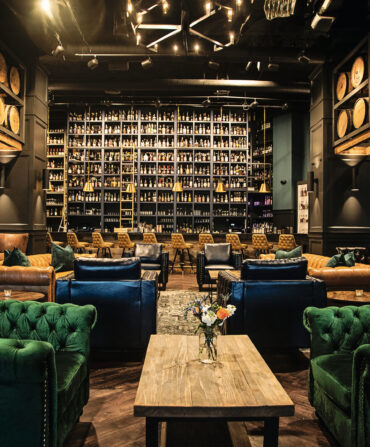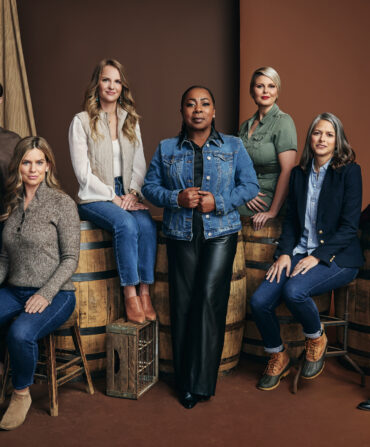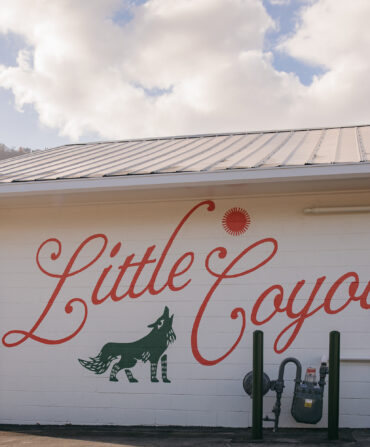Food & Drink
Welcome to BBQ University
Armed with a notebook, a hairnet, an appetite, and plenty of Dr Pepper, a novice backyard warrior enters the hallowed halls of meat science for an intensive lesson in fire, wood, smoke, and plain old great Texas ’cue
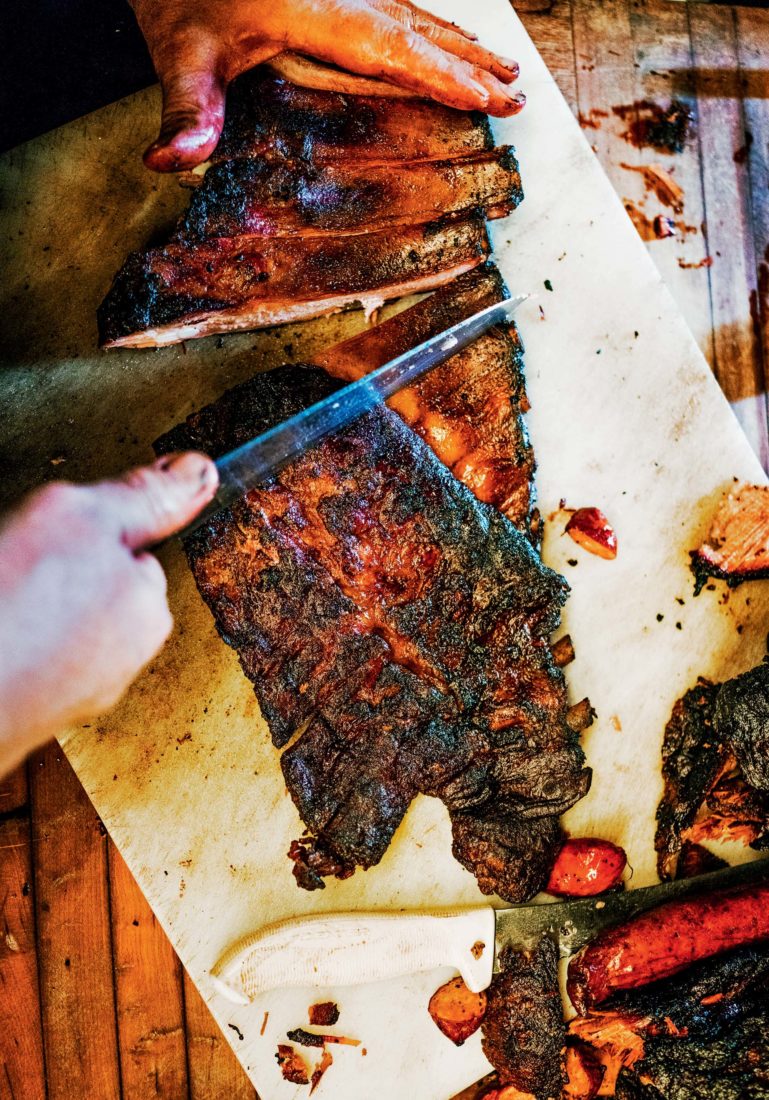
Photo: Randy Harris
The secret to making great barbecue is simple—good airflow. Without steady airflow through your cooker, you get dirty smoke and bitter meat. A guy like Bryan Bracewell, who runs Southside Market & Barbeque in Elgin, Texas, knows several blocks before he arrives at the store what kind of day he’ll have by what’s coming out of the chimney.
Wait. Actually, the real secret—this is so obvious that people forget it—is a great piece of meat, because what goes in your smoker is what comes out. Great meat, like Our Savior, forgives your mistakes. At least, also like Our Savior, the smaller ones. Then again, great pit masters—I mean somebody with smoke in their veins—can turn a so-so hunk of meat into something that makes you want to holler. Which explains why plenty of competitions have been won by guys using USDA Choice, a grade lower than Prime.
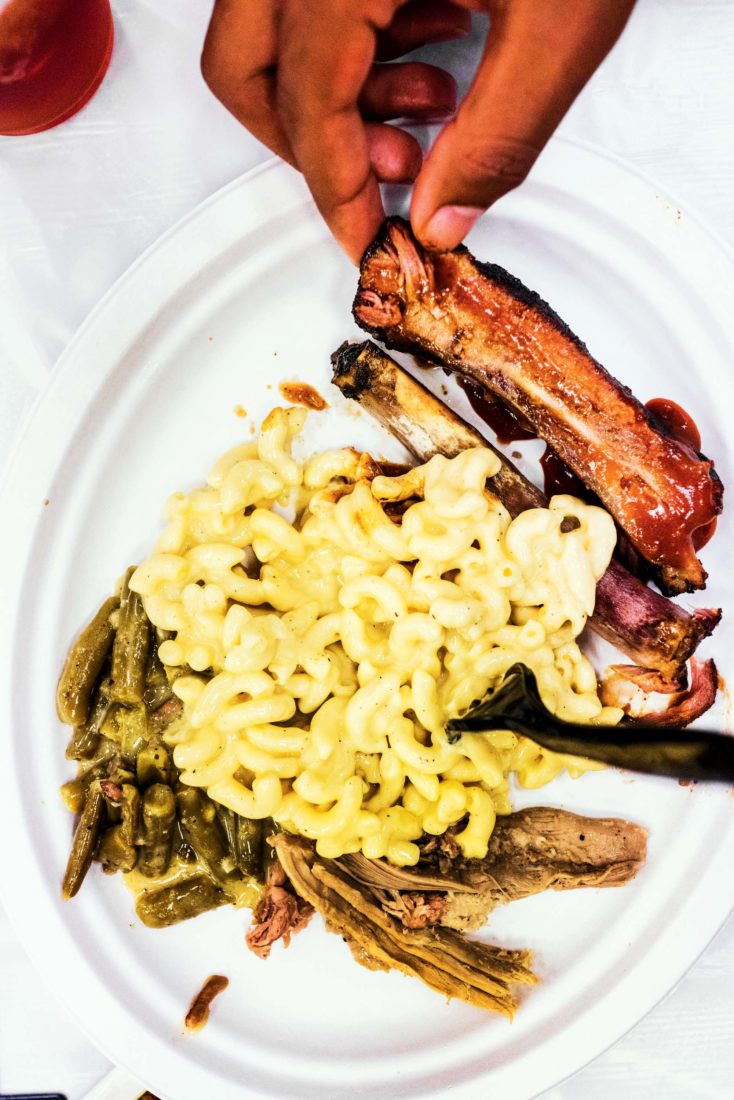
Photo: Randy Harris
BBQ Campers’ rubbed ribs and brisket with macaroni and cheese.
Still, when you get right down to it, you and your cooker will never make beautiful ’cue together unless you know yours like your spouse, maybe even your dog. Doesn’t matter whether it’s a $99 Weber or a $25,000 A. N. Bewley that can do 450 whole chickens at once. No two cook the same. You’ve got to break it in, learn its hot and cold spots, and keep it clean. Cold spots, incidentally, aren’t a flaw. Most professionals rely on those cooler areas to keep smaller cuts from overcooking. While we’re on the subject, if it rains, get that wet ash out pronto. I didn’t quite follow the chemistry, but here’s the gist: If it’s metal, it will rust. And wet ash is to rust as Miracle-Gro is to tomatoes.
So there’s no one secret. There are a bunch, and sometimes they contradict one another. This is what I’m learning at the seventh annual Barbecue Summer Camp, a weekend immersion into the science of barbecue put on each June by Foodways Texas and the Meat Science Section of the Department of Animal Science at Texas A&M University in College Station. Not everything is bigger in Texas, but the colleges sure are. Texas A&M is about the size of Rhode Island, with its own airport and buildings that probably have their own weather systems set about a bicycle ride apart. Looming up out of the prairie over all of it is the 102,733-seat Kyle Field, which has a video screen larger than the lot my house sits on and acoustics that make visiting teams go deaf. It would make an ideal venue for the next Hunger Games.
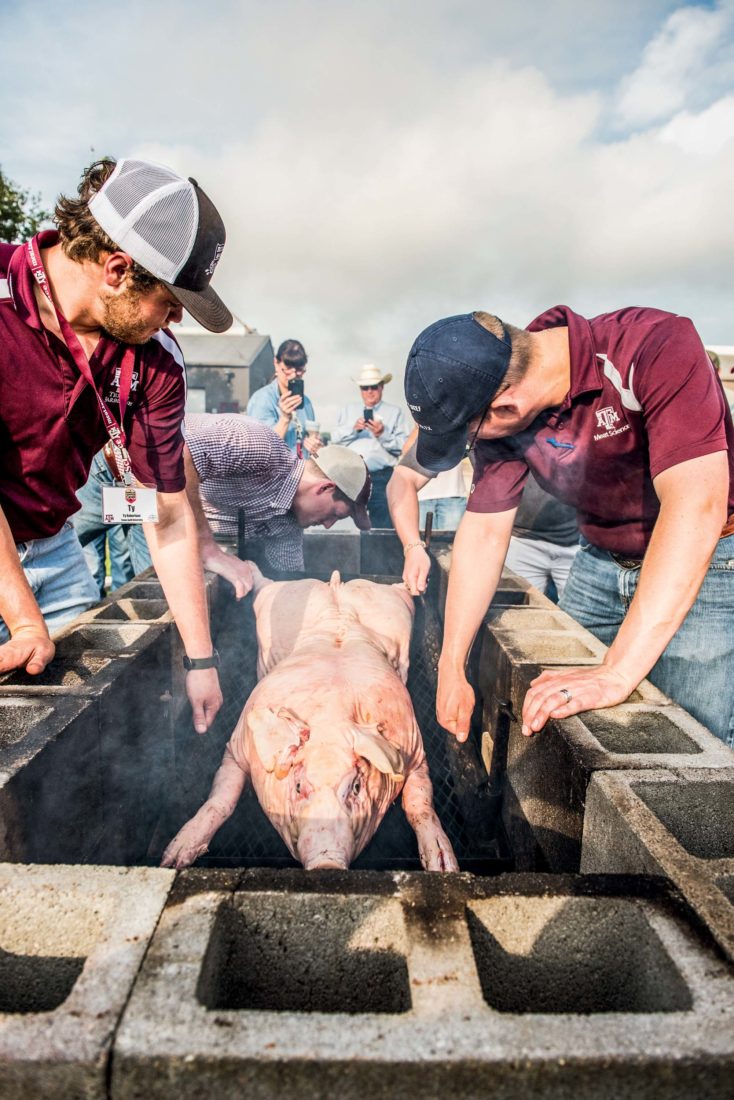
Photo: Randy Harris
A whole hog cooking demo.
Tickets for the Barbecue Summer Camp aren’t just in high demand. The barbecue obsessed have been known to snap them up within minutes. Now the sixty or so attendees are admitted by a lottery system. “We could fill fifty of these a year, but the university doesn’t have the time or space,” says Kelly Yandell, a cheerful recovering attorney who serves on the Foodways Texas advisory board.
Our ringleader for the three-day weekend is Dr. Davey Griffin, a professor of meat science and an extension meat specialist within A&M’s vast Department of Animal Science. Beyond our tiered auditorium in the Rosenthal Meat Center lies a complete harvesting facility—including four cavernous refrigerated rooms, three smokehouses, two cutting rooms, and a meat-packing area. Professor Griffin, casually dressed in an Aggie maroon polo shirt and slacks, salutes the class with a big “Howdy!” and smiles when the greeting is hammered back. “Must be a good number of Aggies out there,” he says approvingly. (“Howdy” is both the university’s unofficial greeting and a code word indicating a love of All Things Aggie.) Griffin got his undergrad and graduate degrees here and has been in meat all his life. Later, describing how cattle are fattened for “harvest,” he’ll pat his own ample chest and stomach and observe, “A cattle buyer would call me ‘well finished.’” He introduces ten students, who have voluntarily given up their weekend to pitch in and clearly adore the man. They are all so sincere, helpful, and well-meaning that if my own daughter were among them, I’d know I was being set up for a prank. Then I find that these kids all grew up on or around farms, most of them in Texas. Sarcasm doesn’t prosper in that soil.
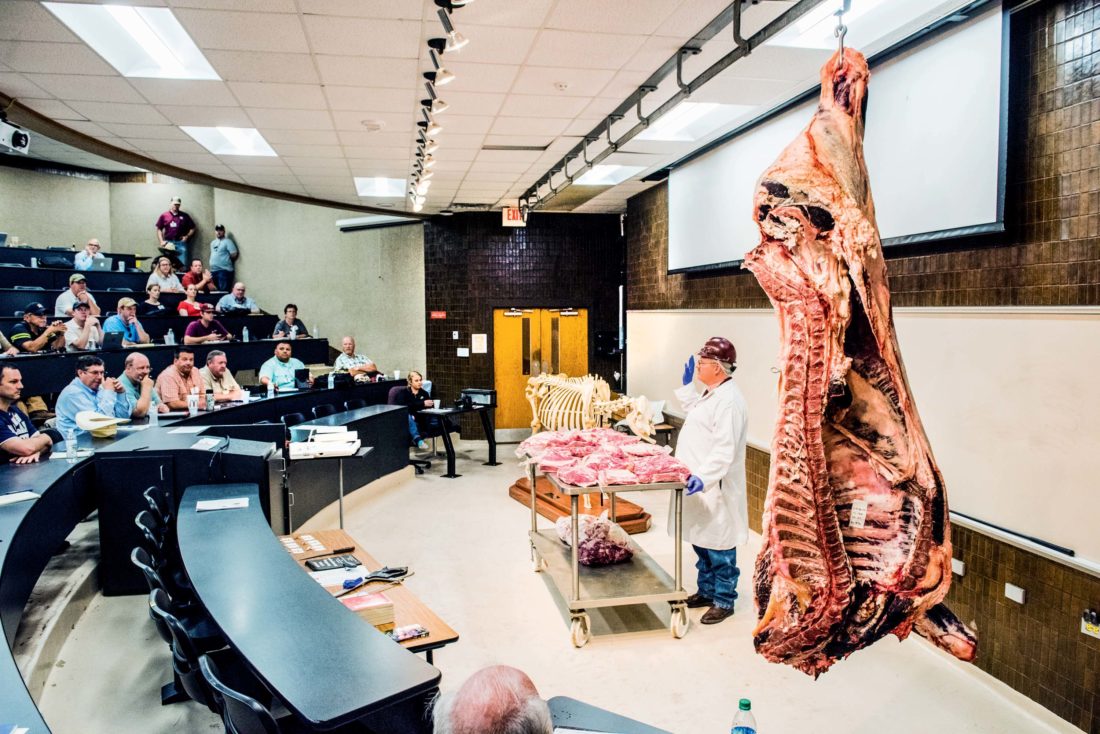
Photo: Randy Harris
Texas AM professor Davey Griffin gives camp attendees a lesson on the finer points of meat.
With its focus on barbecue science, the Summer Camp is two and a half days of drinking from a fire hose, and I immediately discover that I’m way out of my depth. As we introduce ourselves the first morning, there are a good number of backyard warriors such as Douglas Schriever, whose brisket went from “good to great” after he attended Camp Brisket, which Foodways Texas and A&M offer each January. When he casually mentioned to his wife that he was considering this camp, his wife told him, “‘No, honey. You need to go,’” he says. “So here I am.” But even the amateurs are serious cooks. Later, after a panel on selecting a cooker, I’ll hear him say, “Two things a man can’t ever go too big on: gun safes and barbecue cookers.”
Then there are the competition cooks looking to pick up a trick or two, guys in the business continuing their educations, and others considering starting a store. This is a group where the confession that you have six Big Green Eggs in your backyard is as scandalous as owning six pairs of pants. One woman announces her intention to spend her next vacation traveling to “four or five” different manufacturers before selecting “the best” cooker. After the camp—during which we’ll be told repeatedly that there is no “best” cooker—her determination will seem, if anything, bolstered. Some of us want answers, dammit. Meanwhile, the only barbecue recipe I know isn’t even for real barbecue. What you do is throw a venison roast and a can of root beer into a Crock-Pot, cook on low for eight hours, then shred it and douse it with whatever sauce is on sale. It works for me. My outdoor cooking skills were handed down by my dad and chiefly focus—like most of his instruction—on what not to do. Propane is unnatural. You use charcoal briquettes with no lighter fluid. And you definitely don’t use those awful briquettes with the lighter fluid already in them. You cook by feel and nervously, because anything past medium-rare is a sin. That’s the totality of my knowledge.

Randy Harris
In short, I’m about to be handed my hat. Among the people who will be confusing me are the university’s meat scientists, some of the best pit masters in Texas, and experts from companies that make cookers and flavorings. Any one of these people could talk for three days, but we’re going to take a stab at all of it: pit design and maintenance, fire building, the properties of wood and smoke, microbes and thermometers and food safety. We’ll learn about spices and seasonings and sauces, the chemistry of rubs and marinades. We’ll get anatomical overviews and cutting demonstrations, learn how meat is graded and what those grades mean. But knowledge doesn’t necessarily make you smarter. Sometimes it just makes your confusion more nuanced. Take meat grading. Grades are based on a combo of marbling (more is better) and physiological age (younger is better). But paying for Prime, for example, doesn’t guarantee you a better piece of meat. What it buys is a higher probability—about 90 percent—that, on a scale of 1 (bad) to good (8), you’re getting a piece of meat that ranks above 5.
The assimilation of knowledge is made more appetizing and impossible by twice-daily “heavy tastings” of amazing brisket, ribs, sausage, and steak, along with sides and dessert. After lunch, enough blood reaches my brain to allow me to draw stick figures in my notebook, but that’s about it. It doesn’t matter how many Dr Peppers you help yourself to from the ice chest in the hall. I’m also struggling with a vague fear that we’re being fattened for a reason. Every time I go to the men’s room, I half expect someone to jump out and stamp me with a meat grade in blue vegetable-dye-based ink.
After a while, I suspect that I’m not alone in my mystification. Maybe there are others naive enough to think
that, say, salt is pretty straightforward. Then we’re given a handout that runs to three pages and nineteen categories of sodium chloride. There are sea salts (Anglesey, Alaea, Sal de Tavira, Fleur de Sel de Guerande, etc.), smoked salts, flake, kosher, volcanic, brining, pickling, and, of course, Jukyeom, which is a Korean salt roasted in bamboo tubes whose ends have been stuffed with mineral-rich clay that creates…I didn’t get the rest of that. A cup of flake salt, with its large, plate-like (lamellose) crystals, may weigh less than half of a cup of table salt. And that “kosher” designation doesn’t mean you’re out of the weeds. Some of those are twice as salty as others. So the takeaway is, well, forget it, because we’re already on to smoke. That handout is six pages and includes a molecular drawing of the compound guaiacol. I’m just beginning to get a handle on smoke—which is nothing more than the gases and fine particles of carbon produced by wood’s three major components (cellulose, hemicellulose, and lignin) when they undergo pyrolysis at six hundred degrees—when we move on to a more complicated aspect of smoke, the Maillard reaction. But at the words “What begins as a simple reaction between amino acids and sugars quickly becomes very complicated at a molecular level…” my mind snaps shut like a box turtle at a fireworks display and I rise from my seat and go get another Dr Pepper. And then I check my phone to see how long until our next heavy tasting. That’s the strange thing about barbecue. You eat until you’re pretty sure that, should you ever again experience appetite, what you’ll want is a salad. Two hours later, you’re craving more barbecue.

Photo: Randy Harris
Big smiles and good eats at Kreuz Market in Lockhart, Texas.
Now that we’ve won a seat with the Barbecue Brain Trust, some of us are geeked out, grooving on the buzz of it all and becoming manic. We’re in a hurry. Meanwhile, the pit masters vibrate at lower frequencies and seem far away. They are taciturn people who spend sixty or seventy hours a week over a hot pit. They’re more like bricklayers than architects. I think of Calvin Trillin’s line, “…saying that labor costs can be held down by not having [barbecue] cooked slowly over a wood fire by a sullen man with a squint was like saying that a symphony orchestra would be cheaper without the violins.” But we’re too excited. Most of us aren’t all that curious about studying and understanding the process. We want, for example, to know the best wood to use. Asked what he uses, Russell Roegels, of Roegels Barbecue in Houston, shrugs and says, “Post oak.”
“Why? Is there something special about post oak?” “Well, yeah. There’s a lot of it in Texas.”
“Is that white oak or red oak?”
“I don’t know.”
“Well, try it this way then. Does it have lobed leaves or pointy leaves?”
“I don’t know. I don’t cook leaves.”
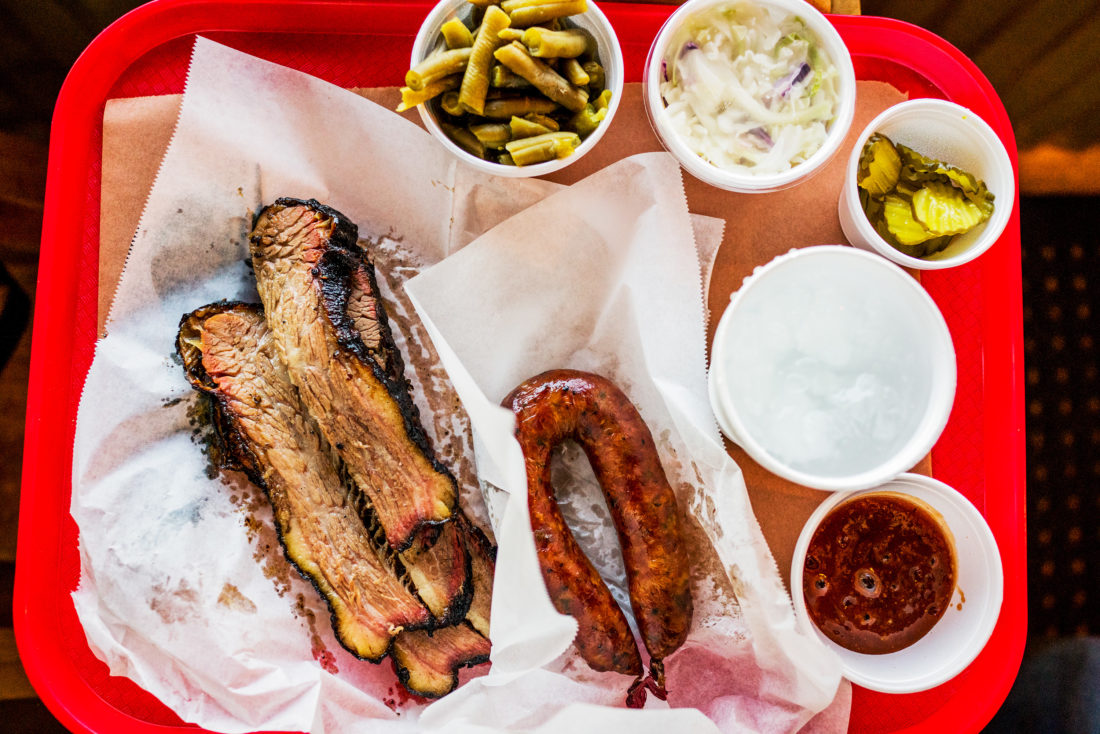
Photo: Randy Harris
Lunch at Kreuz Market.
My barbecue epiphany comes the first afternoon, when we’re bused to lunch at Martin’s Place, a few miles away in Bryan. A hole-in-the-wall that Martin Kapchinskie built in 1925 to service travelers on the one-lane country road between the university and the town, the original store had a public phone, gas, groceries, and barbecue. It still sits off by itself, a little brick building with scraggly bushes and a gravel parking lot. Walking through the door transports you back sixty years. The horseshoe-shaped counter has ten stools. Before each is a dark maroon circle where hundreds of thousands of plates have worn through the Formica. A four-top has a sort of four-pointed star of the same hue at its center from the slapped-down tiles of dominoes players long gone. The echoes of those slaps hang in the air. A hand-scrawled sign advertises peach or blueberry cobbler for $1.99, a dish of BlueBonnet vanilla ice cream for 99 cents. The acoustic tile ceiling has been stained gray from smoke. Beyond is the open door to the cramped pit. We wait our turns and file in ten at a time.
Inside, hunched over a smoking brick structure five feet tall and twelve feet long that looks like some kind of Aztec sarcophagus is Steve Kapchinskie, Martin’s grandson, who has been cooking here for forty-three years. The place is dim, hot, and full of eye-stinging smoke, like some circle of hell for people who did bad things but still deserve to eat well. I drop to a knee on the pretext of taking notes.
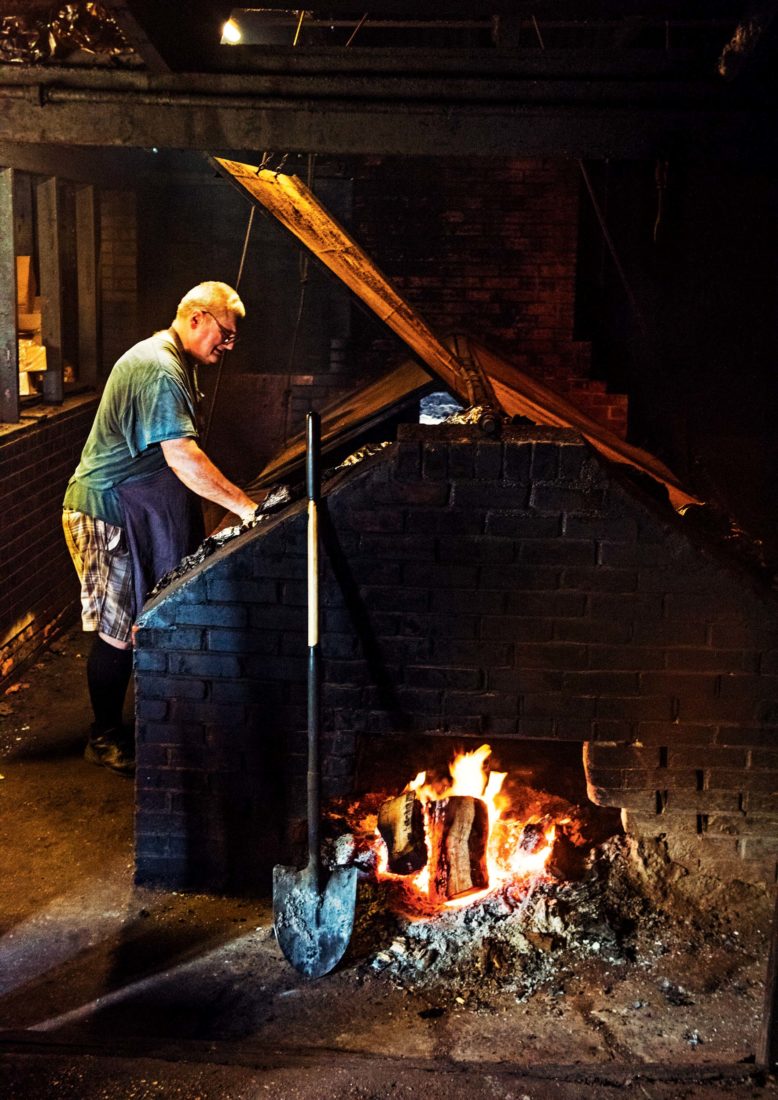
Photo: Randy Harris
Pit master Steve Kapchinskie at Martin’s Place.
Kapchinskie cooks from 5:00 a.m. to 7:00 p.m. He’s a husky man in oversize glasses who wears black compression socks, just like all the ladies in the kitchen, who also wait tables. Unburned ends of logs protrude from the pit’s bottom vents. He manages the fire with a shovel and a garden hoe, their long wood handles blackened and cured from smoke. Stalactites of creosote hang from the ceiling. You can see a small square of sky through a chimney. Kapchinskie tugs on a pulleyed rope that lifts a lid, and a cloud of smoke billows out, clearing to reveal a half dozen briskets. He pokes each with a judicious finger. He hovers his hand palm down over the fire, looking for hot spots and dousing them with water from a tomato-paste can. There are no dials or gauges in sight. “I cook by feel,” he explains. He adjusts the fire by the pit’s vents and doors, even the door to the room itself. “Only thing about cooking like this is you can’t leave the fire,” he says. “I left for one minute once and ruined four hundred dollars’ worth of meat.”
Today is not a good day for cooking. Too humid. Low barometric pressure slows the draw. “These pits were built in 1939,” Kapchinskie says. The kitchen stove needs a new chimney, but that would mean another hole in the roof, which would mean bringing the whole building up to code, which is impossible. He’s sixty-one. He figures he can go at least several more years, get the business up to the century mark. His doctor—whom he has known since high school, when he was Kapchinskie’s trainer—says he’s in pretty good shape, just needs to drink more fluids. The doctor recently advised him to try Pedialyte. We stagger out to let the next group in.
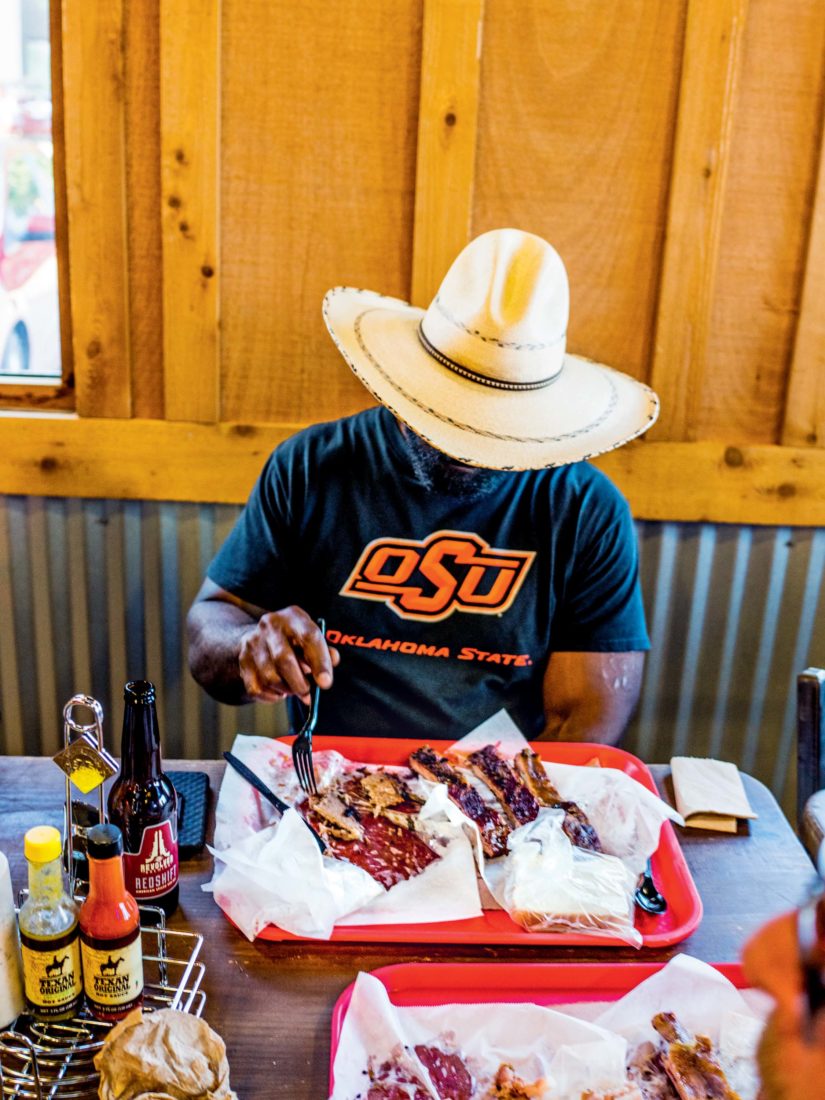
Photo: Randy Harris
Campler Enith Hancock digs in at Kreuz Market.
As we wait for our feeding, Robb Walsh, a Foodways Texas co-founder and food writer, sets us straight about a couple of things. First, there’s no one style that’s “Texas barbecue,” he tells us. Every cultural group to ever cook meat over wood in the state has a legit claim to that. The Caddo Indians had been roasting game over open fires for centuries before Europeans showed up. Early Spanish shepherds turned skewered lamb and kid goats over coals. The Mexicans had their barbacoa, meat wrapped in maguey leaves and placed in pits with hot coals, then buried. Slaves who arrived with Southern cotton growers to plant the fertile river bottoms in the 1820s brought their barbecue, pork cooked in long, deep, wide pits. Beef didn’t become the dominant meat in Texas until after the Civil War. Czech and German immigrants brought a firm belief that well-smoked meat, seasoned with salt and pepper, needed no sauce. Kreuz Market in Lockhart opened in 1900, and that’s still the way they serve it, on a sheet of unwaxed butcher paper. Long story short, Texas barbecue is what Walsh calls a “feisty mutt” of traditions, though you wouldn’t want to be the guy who told a Texan that his barbecue wasn’t really Texan.
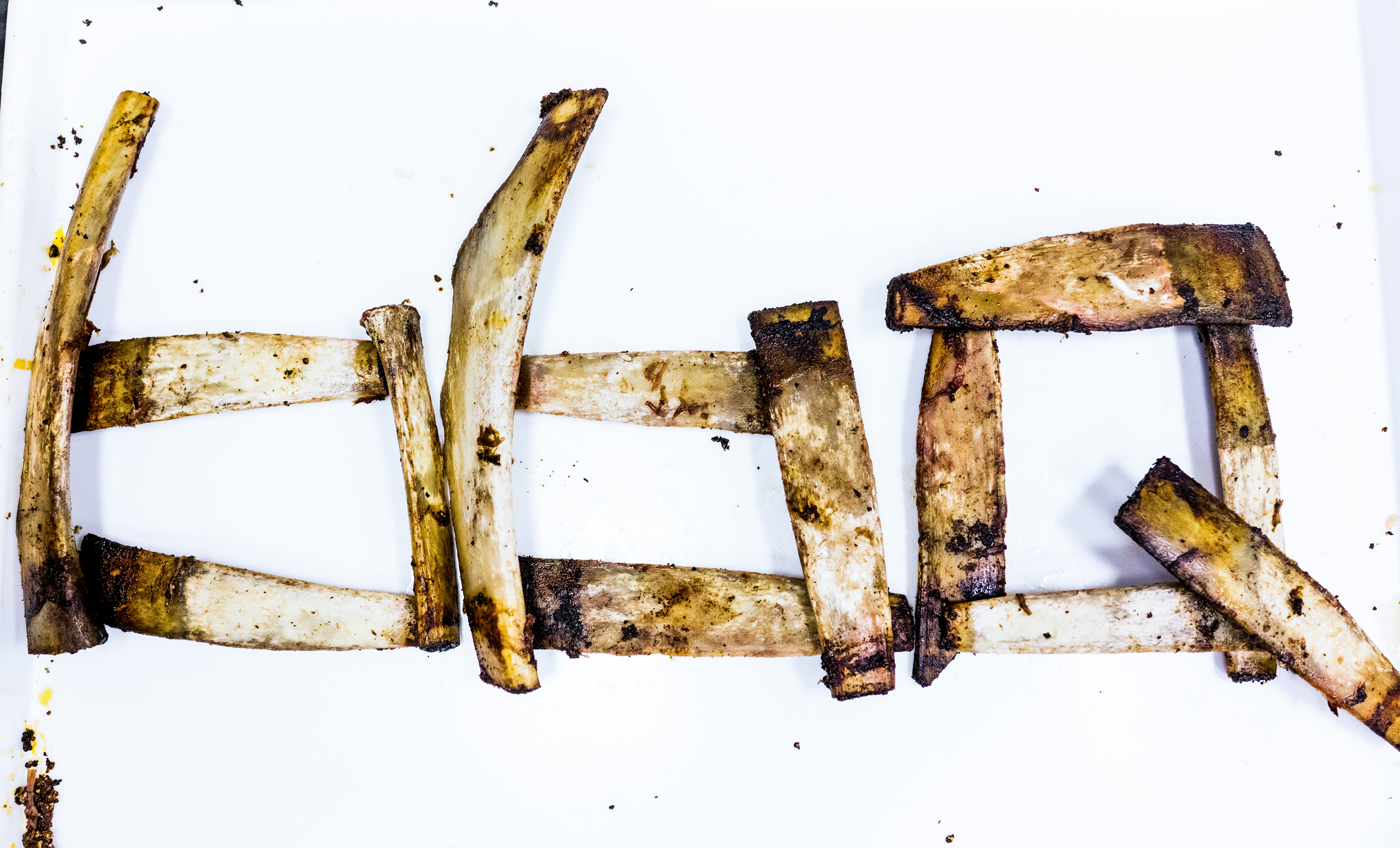
Randy Harris
The other thing is that barbecue was never meant to be haute cuisine. It evolved as a way to make the less-desirable cuts more palatable and to feed people so they could get back to work. Like politics, all barbecue is local. It’s the product of local resources, customs, traditions, and history. “There’s no best barbecue any more than there is a best song or painting,” Walsh says. Real barbecue is about soul, about those local traditions and the keepers of the flame. It’s the grit and humility and perseverance and pride of the people who lived and died here. It’s about guys like Steve Kapchinskie. Martin’s has no website or Twitter feed. It rarely makes “best of ” lists. The Yelp reviews can be a bit sniffy. But sit down at the counter to hot brisket and ribs, your plate joining the circle made by thousands before you, and something happens. You feel the presence of something powerful in this room. There is both an enduring humility and pride here, and you can’t separate one from the other any more than you can smoke from fire. You crunch through the ribs’ outsides into the moist meat inside. You nibble every last shred off the bones as you waver about which cobbler to have for dessert. Or maybe the coconut cake. And you don’t for a moment wish you were anywhere else. What you wish instead is that all those people clamoring for a seat at whatever joint is leading the ratings this week were smart enough to come here. Because this is the real deal. If there’s a secret to great barbecue, it’s right here in your hands.


